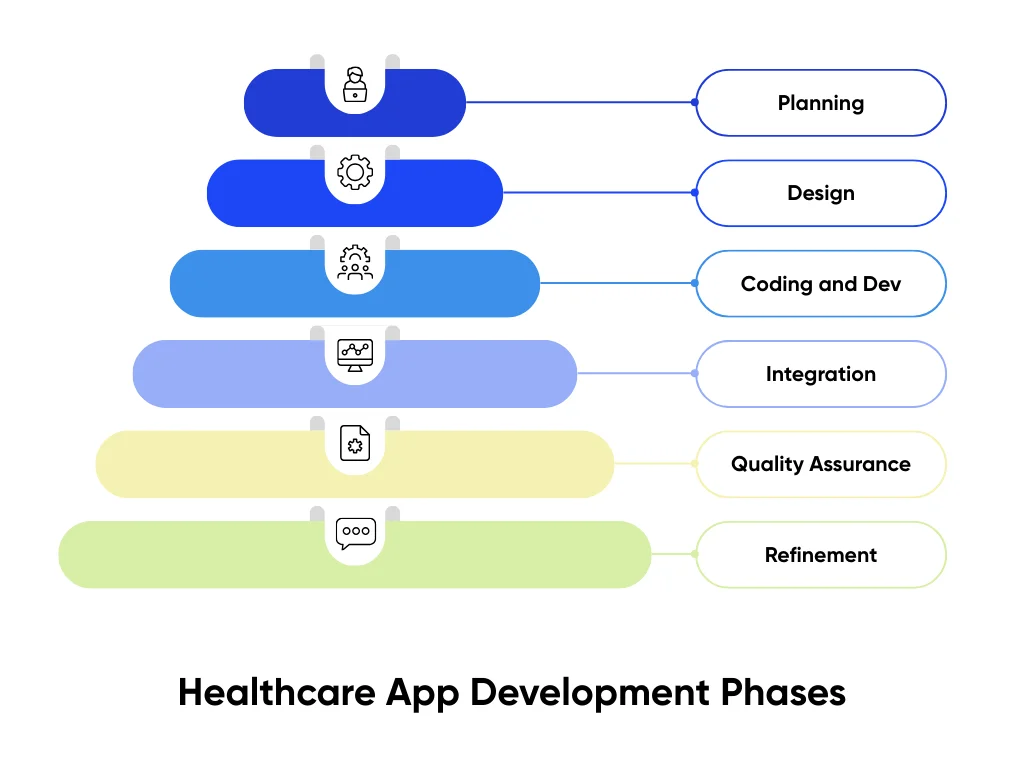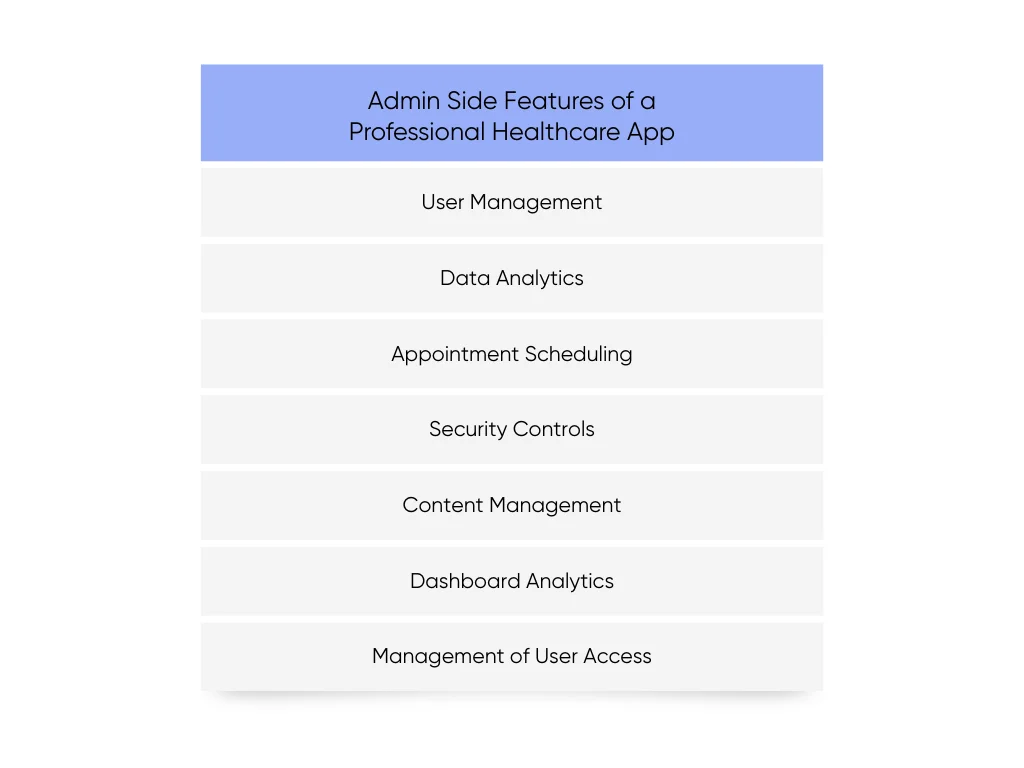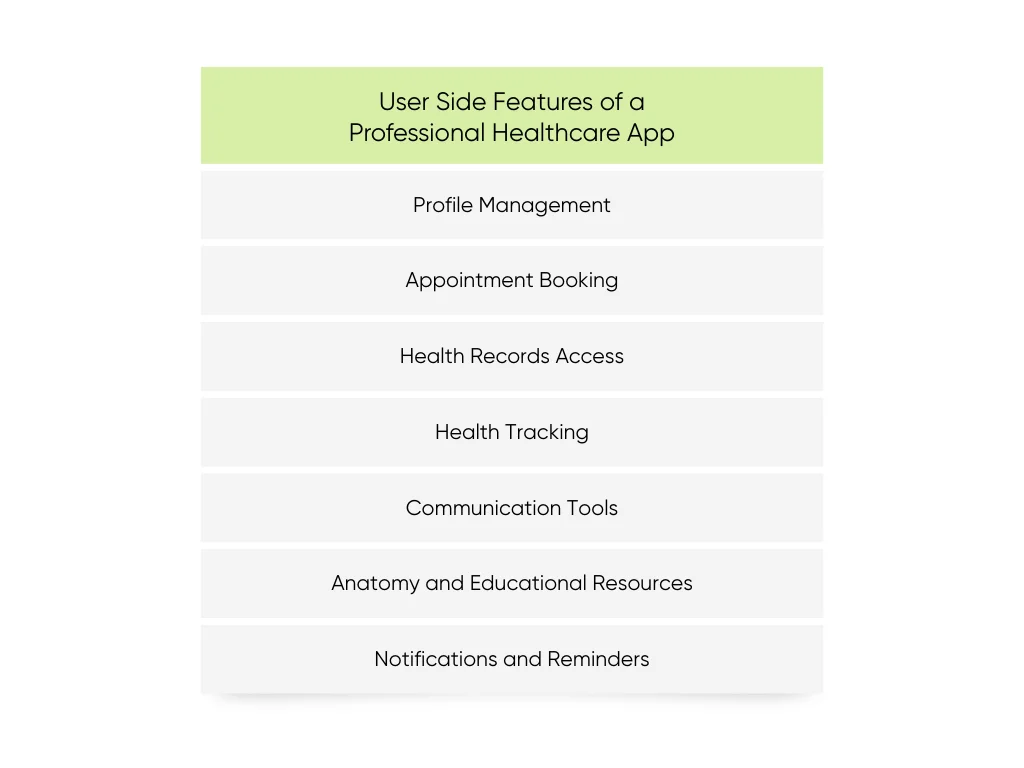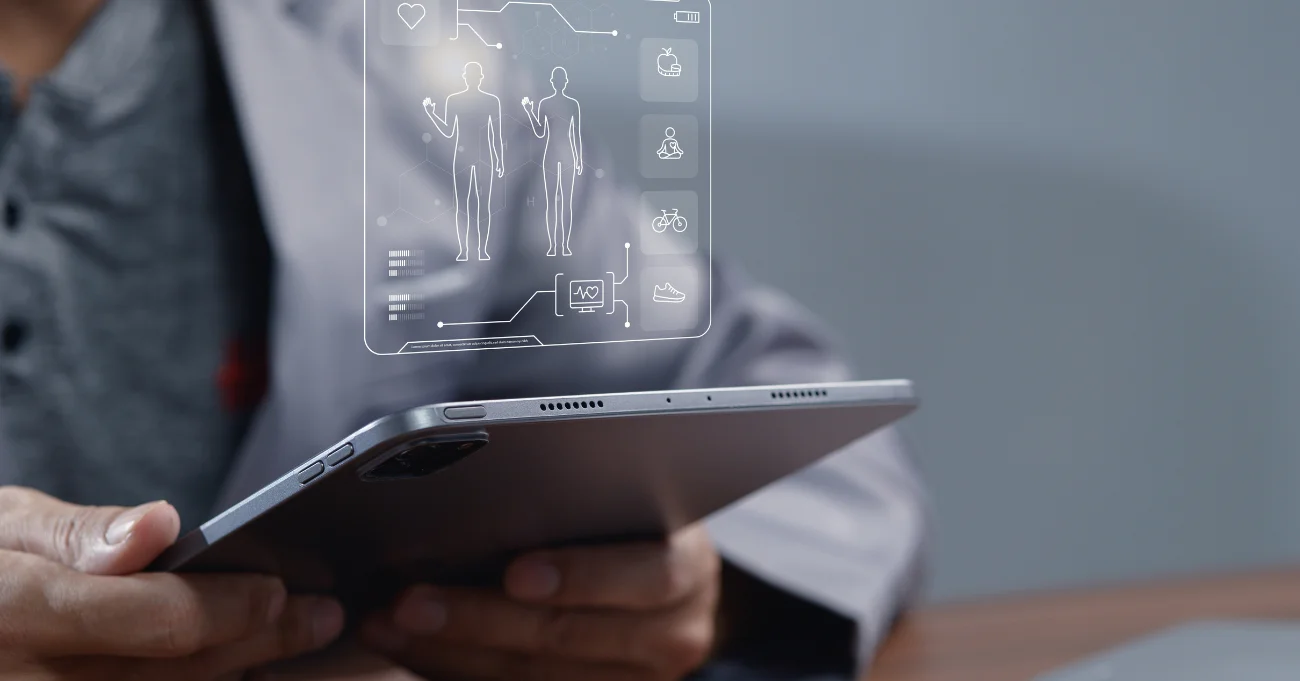Professional healthcare apps have become essential tools for improving patient outcomes, with their benefits to operational efficiency and clinical decision-making. Now that smartphones, tablets, and even wearable devices are now deeply integrated into everyday life, healthcare apps have become part of the day-to-day for most people. But how do you build a healthcare app that delivers seamless UX, achieves consistent compliance, and delivers on clinical needs?
Aloa knows exactly how. Whatever your clinical needs, we can build a healthcare app that works for you and your patients. Our AI expertise lets us tackle challenges like advanced data processing, automation, and telehealth implementation, no matter how complex they may be.
In this blog, we'll take you through each of the steps involved in how to create a medical app. We'll explore the development process, standard features for both the admin and user sides, and important considerations to remember during the process.
By the end, you will have a clear, practical roadmap to developing your own professional healthcare apps, plus valuable insights to help you avoid common pitfalls and flesh out your solutions in a way that truly supports patients and providers. Let’s get started.
TL;DR
- Building with guidelines like HIPAA and GDPR in mind from the start allows you to integrate patient data protection in every feature, ensuring compliance and user trust.
- It’s essential to establish clear requirements and app purpose (telemedicine, EHR, fitness, medication management, mental health, etc.) and aligning features to real clinical needs before beginning development.
- Put together the right team with the right kind of experience in healthcare, security, compliance, scalability, and strong UX to ensure long-term viability.
- Make sure to implement rigorous pre-launch testing, ongoing performance monitoring, and user feedback analysis. This ensures your app works as advertised on launch, patches are prompt, and updates are effective at keeping it reliable and secure.
Steps for Building Professional Healthcare Apps in 2026
Building professional healthcare apps requires strategic planning for a tailored solution that aligns with specific medical needs. Explore our comprehensive guide on building professional healthcare apps to refine your approach and discover best practices for seamless development, enhancing the overall effectiveness of your healthcare project.

Step 1: Consider Legal and Regulatory Requirements
First, consider legal and regulatory requirements to ensure adherence to healthcare standards like HIPAA for patient data security. Adhere to HIPAA standards using solid data encryption, robust access controls, and regular security audits to ensure patient data security and confidentiality.
Prioritizing patient confidentiality through secure data storage and obtaining explicit user consent for data usage within the app is crucial. Collaborating with legal experts specializing in healthcare compliance ensures that the healthcare app meets all necessary legal standards and maintains compliance amidst evolving healthcare regulations.
This commitment to regulatory adherence fosters trust among users and healthcare providers, guaranteeing the protection of sensitive patient information.
Step 2: Gather Requirements
Next, gather requirements by understanding different healthcare mobile app types and their distinct purposes. Gathering requirements involves identifying the app's functionalities, user needs, and goals. Here's a breakdown of the types of healthcare apps commonly developed:
- Telemedicine Apps: Facilitate remote consultations between patients and healthcare professionals, enabling virtual diagnosis and treatment. These healthcare apps connect patients directly with health professionals for disease references, remote consultations, and advice for medical conditions.
- Health and Fitness Trackers: Monitor and track various health metrics like steps, heart rate, disease prevention, and sleep patterns, promoting healthier lifestyles.
- Medication Management Apps: Aid medication adherence by providing reminders, dosage schedules, and pill identification features.
- Electronic Health Record (EHR) Systems: Enable secure storage and accessibility of patient logs, ensuring efficient healthcare management.
- Mental Health and Wellness Apps: Offer resources, therapy sessions, and coping mechanisms to support mental well-being and emotional health.
Each type of healthcare app serves a specific purpose, ranging from remote consultations to tracking health metrics or accessing comprehensive disease information, catering to diverse healthcare needs in today's digital landscape.
Step 3: Source The Right Healthcare App Development Team
After that, source the right healthcare app development team through a reliable partner. Choosing the right healthcare app team requires careful thought. Look for team members with a proven record in secure, user-friendly app development, emphasizing experience in robust security measures and compliance with privacy standards.
Check their expertise in prioritizing patient data security, considering their grasp of industry regulations beyond HIPAA to ensure compliance with diverse healthcare standards. Also, evaluate their capability to create flexible solutions meeting changing healthcare needs while emphasizing user experience and robust security.
Choosing a skilled team like Aloa assures a dependable, compliant, and secure healthcare app, paving the way for success in the evolving healthcare space. With expertise in software outsourcing, our experienced developers specialize in healthcare software, providing valuable insights and guidance for your project to meet industry standards and achieve peak functionality.
Step 4: Start Formal Development Process
Moreover, start the formal development process by initiating structured planning, design, and coding. Beginning the formal development process is critical in bringing the healthcare app to life. This phase involves structured planning, design, coding, and integrating essential features and functionalities identified in the previous steps.
Here are the essential development phases to consider for building professional healthcare apps:

- Planning: Detailed planning involves outlining the app's architecture, features, user interface design, and technical requirements.
- Design: This phase focuses on creating wireframes, prototypes, and visual designs that align with the app's objectives and user experience (UX) standards.
- Coding and Development: Skilled developers utilize programming languages and frameworks to build the app's backbone, incorporating functionalities such as user authentication, data storage, and interactive features.
- Integration: This phase involves merging different modules, testing their interoperability, and ensuring smooth communication between various app parts.
- Quality Assurance (QA): Throughout the development process, rigorous testing and quality assurance are conducted to identify and address bugs, usability issues, and performance glitches.
- Refinement: Feedback from testing phases is used to refine the app further and to enhance user experience, performance, and overall functionality.
The formal development process is structured and iterative, ensuring the app is built systematically, meets quality standards, and aligns with defined requirements. This phase lays the groundwork for a robust and functional healthcare app.
Step 5: Test and Launch
Additionally, test and launch the healthcare app, ensuring functionality, security, and user satisfaction. It involves rigorous checks for device functionality, usability, security, performance, and compatibility. This meticulous testing phase ensures that the app meets quality standards and adheres to healthcare data security protocols like HIPAA.
Upon successful testing, the app is launched strategically. A soft launch or beta test gathers real-world feedback before the full launch. App store submission, marketing efforts, and collaborations build anticipation, ensuring a successful introduction and a seamless user experience.
Thorough testing mitigates risks and ensures a positive user experience, while a strategic launch enhances visibility and sets the stage for the app's success in the healthcare market.
Step 6: Monitor and Evaluate
Furthermore, monitor and evaluate post-launch for ongoing success and continuous improvements. Continuous monitoring involves tracking app performance, user feedback, and technical issues. This constant vigilance ensures swift identification and resolution of emerging issues, maintaining optimal functionality.
Regularly analyzing user data, feedback, and KPIs gauges the app's effectiveness, understanding user behavior and areas for improvement. Leveraging this data-driven approach allows adjustments to align the app with evolving needs and tech advancements.
Additionally, proactive measures like implementing updates, security patches, and feature enhancements based on user insights contribute to the app's longevity and relevance. The iterative monitoring, analysis, and improvement process ensures that the healthcare app remains a valuable and trusted tool in the dynamic healthcare landscape.
Step 7: Continually Improve and Update
Finally, continually improve and update the app by incorporating user feedback and staying abreast of industry standards and regulations. Collecting feedback and monitoring market trends identifies areas for improvement. This process steers updates and optimizations, aligning the app with changing user needs and tech advances.
Moreover, staying attuned to regulatory changes and industry standards, such as HIPAA compliance, ensures that the app remains in line with the latest healthcare regulations. This proactive approach maintains user trust and mitigates any potential legal risks associated with non-compliance.
Connecting with users via in-app notifications or newsletters about updates maintains transparency and user engagement. The app stays competitive, meeting healthcare industry demands by focusing on innovation from evolving healthcare research and user-centric improvements.
Essential Features of a Professional Healthcare App
When building professional healthcare apps, it’s crucial to incorporate essential features that cater to the diverse needs of medical users. These features distinguish the best apps in the healthcare market, ensuring top-notch user experience and functionality. Here are some considerations when determining the feature set for your app:
Admin Side Features of a Professional Healthcare App
Administrators play a significant role in overseeing the operational facets of healthcare systems. Healthcare apps offer a range of features tailored to streamline various tasks and meet the distinct needs of administrators:

- User Management: Enables admins to efficiently manage user accounts, permissions, and access levels.
- Data Analytics: Provides comprehensive tools for monitoring user activity, app performance, and data trends. It employs artificial intelligence for personalized recommendations and predictive analytics.
- Appointment Scheduling: Admins can organize and manage appointments, allocate resources, and streamline scheduling processes.
- Security Controls: Offers robust security measures to safeguard patient data, ensuring compliance with healthcare regulations.
- Content Management: Facilitates the management and update of app content, such as articles, guidelines, or resources.
- Dashboard Analytics: Provide comprehensive analytics and reporting tools for administrators to track usage patterns, monitor user engagement, and gather insights into the app's performance, aiding decision-making and future enhancements.
- Management of User Access: Enable administrators to manage user access levels, permissions, and roles within the app, ensuring appropriate data access and adhering to security protocols, thus maintaining data integrity and confidentiality.
User Side Features of a Professional Healthcare App
When designing a healthcare app from the user's perspective, it's crucial to incorporate features that enhance usability and address specific health-related concerns. Here are critical user-side features to consider:

- Profile Management: Allows users to create and manage their profiles, update personal information, and set preferences.
- Appointment Booking: Enables users to schedule, cancel, or reschedule appointments with healthcare providers.
- Health Records Access: Grants users access to their medical records, test results, prescriptions, and treatment history.
- Health Tracking: Provides tools for users to identify and manage potential risk factors and track health metrics like steps, diet, medications, or vital signs. Users can also access detailed drug information, including dosage and usage guidelines.
- Communication Tools: Facilitates communication with healthcare professionals through secure messaging or video consultations.
- Anatomy and Educational Resources: Integration of an educational section that includes complete anatomy visuals and information with interactive 3D models, diagrams, and content to help users understand their bodies, medical conditions, procedures, and treatments.
- Notifications and Reminders: Implement customizable messages and reminders for users, such as medication reminders, treatment plans, appointment schedules, or health-related alerts, enhancing user engagement and encouraging proactive healthcare management.
Considerations to Take When Building Professional Healthcare Apps
Building a healthcare app in 2026 is an exciting endeavor, though it does pose its hurdles. Here are five essential factors to ensure your healthcare app's success. These considerations can pave the way for innovation and efficiency in healthcare technology.

Regulatory Compliance
Before launching a healthcare app on app stores, ensuring compliance with regulations like HIPAA and GDPR is crucial for patient safety and data privacy. Non-compliance can lead to legal penalties and reputational harm, necessitating rigorous testing and collaboration with legal experts for validation.
Data Security
Healthcare apps must prioritize protecting sensitive patient information through encryption and secure storage. Inadequate data security measures can lead to legal and financial consequences for healthcare providers. Data security is crucial to maintaining trust and confidentiality in the medical field.
User Privacy
When developing healthcare apps, user privacy is essential to safeguard sensitive personal information. Compliance with privacy laws and secure data storage are crucial. Consider integrating features like encryption and two-factor authentication. Regularly updating privacy measures is vital to reducing risks and ensuring user trust and data security.
Clinical Validation
Ensuring the accuracy and safety of healthcare apps is paramount. Clinical trials and testing are essential before market release. Regulatory approvals and certifications validate the app's reliability. Users trust clinically validated apps for accurate information. Healthcare providers or clinical teams must collaborate with experienced developers prioritizing clinical validation.
Interoperability
Ensure compatibility with existing healthcare systems and standards for seamless integration and data exchange, enabling healthcare providers to access and utilize data effectively. Seamless integration enhances efficiency in healthcare delivery and improves patient outcomes.
Key Takeaway
Professional healthcare apps are now essential tools to cater to diverse medical needs. They serve as platforms for innovative solutions, ultimately improving the efficiency and efficacy of patient care. If your business niche involves patient care, investing in these applications can be crucial to streamline operation and elevate patient experiences.
The right software development partner can ensure that your investment leads to the best app for your patients’ use cases. Aloa has the tools and resources to be that partner. From meeting design requirements to staying within healthcare industry regulatory standards, we’re equipped with all of the best practices to help you build your professional healthcare app, and keep it compliant and competitive in a changing medtech landscape.
If you’re looking to get started on your next professional healthcare app, reach out to us, and we’ll help you plan out each phase of the development process. You can also join our AI Builder Community on Discord where you can discuss design techniques and philosophies, and subscribe to our newsletter for the latest in healthcare tech.
FAQs
What are the current trends in healthcare app features for enhancing patient engagement?
Some of the trends that are seeing increasing adoption in modern healthcare apps include:
- Wearable integration: More than just round-the-clock health monitoring devices, wearables are now also collecting data to feed into predictive, AI-driven analytics and insights. This is powering everything from automated e-Prescriptions to real-time alerts to take insulin or seek medical attention.
- Gamification: Game design principles such as points and rewards systems are increasing patient enthusiasm to engage in activities that improve their health and well-being. This fits in neatly with advancements in wearable tech, allowing patients to track their milestones in real-time.
- Healthcare service geofencing: Real-time location intelligence has become invaluable for bringing up directions to critical healthcare services without having to input a search query, which especially matters during emergencies.
At Aloa, we stay on top of the best practices to incorporate these and more. Whether it’s adaptive dashboards or predictive analytics, we know how to design for continuous engagement and better health outcomes.
How can healthcare apps integrate with existing electronic health record (EHR) systems?
Healthcare apps can integrate with EHR systems using standardized, secure APIs built on interoperability frameworks such as HL7 and FHIR. Aloa’s development teams are well-versed in building HIPAA-compliant applications that share data securely and consistently with existing EHR systems.
%20Systems.webp)
What role does user feedback play in the iterative development of healthcare apps?
User feedback is critical for improving usability and ensuring solutions meet the real needs of the patients and providers involved. Involving users early and continuously helps developers identify problems, refine existing features, and find opportunities to build new features. Aloa creates agile feedback loops throughout development, ensuring every release enhances functionality, accessibility, and patient satisfaction.
What are the ethical considerations when developing healthcare apps?
Ethical app development hinges on reducing “black box” qualities, which involves maximizing process transparency, patient privacy, and opportunities to opt out of data use. Aloa extends this to healthcare apps by working continuously to reduce AI bias, displaying detailed consent screens, publishing clear explanations of how our health algorithms work and the data they use, and implementing easy data deletion options.
How can healthcare apps utilize AI to improve diagnostic accuracy?
AI in healthcare apps can help analyze complex health data and support clinical decisions by improving the speed and depth with which clinicians can produce insights. Aloa integrates AI algorithms into healthcare apps to provide clinicians and patients with actionable insights in real time.
What are the best practices for ensuring a seamless user experience in healthcare apps?
A seamless healthcare app experience relies on many of the same UX principles that govern good app design in general:
- Accessible design: Creates ease of use for users of all levels of tech familiarity.
- Intuitive navigation: Brings users to the places they’re interested in more quickly and easily.
- Context-aware personalization: Tailors the app experience to individual users’ health needs, preferences, and clinical context, allowing them to get to the resources and care they need even faster.
Aloa emphasizes patient-centered UX principles, creating responsive interfaces that accommodate diverse users and minimize cognitive load.
How can I build a custom healthcare app tailored to specific patient needs?
Building a tailored healthcare app centers on identifying target patient challenges and defining measurable outcomes for each of them. Aloa’s end-to-end process—from discovery and design to compliance and deployment—ensures each app meets unique medical, regulatory, and user requirements.

